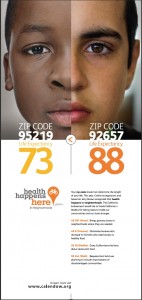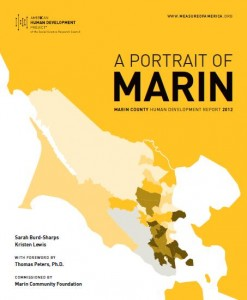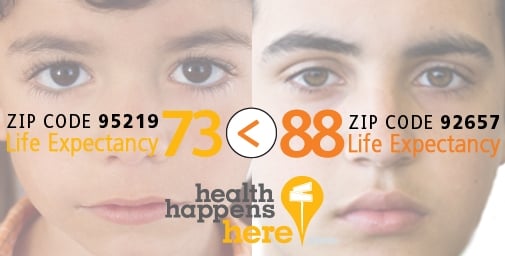MOA Data Featured in CaliforniaCampaign
Last year, Measure of America published A Portrait of California, which examines the well-being of California residents using the American Human Development Index (AHDI). This research was supported by a consortium of organizations hoping to stimulate dialogue and action to address challenges facing California today.
The study, which has already been well-received within the academic and philanthropic communities and is a frequently quoted source for the media, has now become the basis for a California-wide public health campaign.
Research from A Portrait of California is appearing on billboards all over the state, as part of the Health Happens Here campaign, a community-based health initiative supported by The California Endowment, one of the sponsors of A Portrait of California.
One of the first steps involved in calculating the AHDI for California was to determine the life expectancy for people living in each and every neighborhood and county group, using raw data from the California Department of Public Health. Measure of America’s life expectancy calculations are the only ones available for small geographies in California and as such, were among the novel and unique contributions of A Portrait of California.
Measure of America’s life expectancy calculations are the only ones available for small geographies in California and as such, were among the novel and unique contributions of A Portrait of California.
The Health Happens Here campaign uses poignant images of young Californians alongside life expectancy estimates from A Portrait of California to powerfully illustrate the wide gaps in health outcomes that exist between communities within the state. This video, produced by the California Endowment, speaks to how the campaign is using data from the report to motivate people across the state to see connections between social and environmental conditions in their communities and the kinds of health challenges they face as a result.
In the public health community, understanding of these “social determinants of health” is growing. The World Health Organization defines this term as, “the circumstances in which people are born, grow up, live, work and age, and the systems put in place to deal with illness.” It is now important to find ways of conveying this concept to the general population. The Health Happens Here campaign holds great potential to raise awareness among communities throughout California that although doctors and medicines are vital once you are sick, the conditions of our daily lives hold the key to better health and greater longevity. Furthermore, these images draw public attention to inequalities in living standards and health outcomes among California residents, thus encouraging policy makers to target and ameliorate these disparities.
Measure of America is proud to have been involved in The California Endowment’s Health Happens Here campaign through their work on A Portrait of California and is looking forward to the positive impact it will have within the state of California.
A Portrait of Marin’s Widespread Local Impact
A Portrait of Marin, a county-level human development report produced by Measure of America and commissioned by the Marin Community Foundation (MCF), uses the American Human Development Index to assess well-being and needs in Marin County, California. The report compiles and analyzes data from official U.S. government sources to provide accessible, quantitative information on racial and ethnic demographics, economic conditions, health, and education within the county.
The report facilitates interaction between citizens, the public sector, and the private sector by providing a single source and a common language with which to deliberate community issues. A Portrait of Marin is also being translated into Spanish to enable the county’s growing Latino population to better understand aspects of the report that discuss this community’s needs and to take action to address them.
At a a community forum sponsored by the First Presbyterian Church of San Rafael and the Marin Interfaith Council on May 23rd, MCF president and CEO Dr. Tom Peters stated that the Foundation commissioned the report “to promote equity and diversity through the process of engagement”— a way to turn statistical data into tools of empowerment. When we spoke with MCF this June, they discussed how the report has catalyzed both discussion and action in Marin since its publication in January 2012. More specifically, A Portrait of Marin:
- INCITES PUBLIC DEBATE: The report engaged residents by creating a rare and nonpartisan space for them to discuss pertinent issues affecting their everyday lives. After the release of A Portrait of Marin, a lively back-and-forth between impassioned Marin residents emerged in local papers and online, and drew attention to issues of concern such as housing, child care subsidies, immigration, and education.
- INFLUENCES HOUSING POLICY: Experts and advocacy groups within the county are using the report to effect policy change. One such group, Action Coalition for Equity, evoked the report to argue the need for further economic opportunities and housing for low-income families in Marin. The Marin Workforce Housing Trust even remarked that the report offered the most convincing argument for the increase in affordable housing yet. In fact, as reported in the New York Times, a private citizen of note, George Lucas, (while perhaps not directly inspired by the report) will turn his property, Grady Ranch, into affordable housing with MCF’s assistance.
- INFORMS BANK INVESTMENTS: The report brings to light socio-economic gaps within the county, and banks such as Wells Fargo and Union Bank are using the report to fulfill their obligations under Community Reinvestment Act, an act approved by Congress to reduce discriminatory practices in low-income communities.
These examples demonstrate just some of the wide-ranging impacts that a comprehensive human development report can have on local communities. Reports such as A Portrait of Marin are designed to be statistically robust yet clear and accessible, and to help communities identify areas of need and develop policy agendas.
Learn more about Measure of America’s impact and accomplishments, and visit our Publications page for a full listing of human developing reports.
Touring NYC With Marketplace Radio
You might have recently heard an interview on Marketplace with Measure of America co-director Sarah Burd-Sharps. The segment focused on the highs and lows in New York City—more specifically, on Manhattan’s East Side and the South Bronx. These two locales are at both extremes of the distribution of median personal earnings in the entire nation; quite a startling statistic considering they are only six subway stops apart.
Measure of America led a tour of these areas for Marketplace, pointing out how government investment in differing areas is sometimes very uneven. The way the pie is divided has large implications for individuals and communities, as is evident in the quality of local infrastructure and services. We made sure to visit public facilities within the same system in both areas to explore how public resources are allocated. The tour included two branches of the New York Public library system, two parks in the NYC Department of Parks and Recreation, a waste transfer site in the Bronx, as well as a proposed site in the Upper East Side.
East Side, Manhattan
Congressional District 14Annual Median Personal Earnings: $51,507
Sites visited:
– John Jay Park – Carl Shurz Park – Webster Library – Waste Transfer Site
South Bronx
Congressional District 16Annual Median Personal Earnings: $19,043
Sites visited:
– Rainey Park – Dawson Playground – Woodstock Library – Proposed Waste Transfer Site
Six miles and five hours later, plus many more in the recording studio, here you have it: a four-minute clip on Marketplace!With sincere thanks to Marketplace, David Brancaccio (@economy4_0) and Ann Heppermann. Also, stay tuned for more on our Tale of Two’s series. We’ll be following up on this post with examples from other places across the nation.
What do you think about these disparities? Do you see them within the places you live? Leave us a comment below.
MOA Responds to A Portrait of Marin Public Debate
 As co-directors of Measure of America, we are gratified by the lively exchange of ideas among citizens we have seen in Marin County, California over the last two months in connection with A Portrait of Marin, our first-ever county-level American Human Development Report. As always, we aimed to stimulate fact-based dialogue by providing easy-to-use, methodologically sound tools for understanding the distribution of well-being and opportunity.
As co-directors of Measure of America, we are gratified by the lively exchange of ideas among citizens we have seen in Marin County, California over the last two months in connection with A Portrait of Marin, our first-ever county-level American Human Development Report. As always, we aimed to stimulate fact-based dialogue by providing easy-to-use, methodologically sound tools for understanding the distribution of well-being and opportunity.
Commissioned by the Marin Community Foundation, A Portrait of Marin looks at how Marinites are faring by place and by gender, race, and ethnicity using the American Human Development Index, a measure of life expectancy, education, and earnings.
In other words, we combined official statistics on how long people are living, the proportion of children and young people who are in school, the highest academic degree adults have attained, and the salaries of typical workers into a single number that falls on a scale from 0 to 10. GDP tells us how the economy is doing. The American Human Development Index tells us how people are doing.
The Index is based on a methodology developed at the United Nations that has been in use for over 20 years in 150 countries. This work became the international gold standard for measuring well-being because it provided a much-needed diagnostic tool for policymakers and the general public to understand where they were succeeding in creating opportunity and where more effort was needed. And rather than focus only on economic metrics, the human development approach offers a way to address health, education, and living standards in the interconnected way that people actually experience them and opens a space for developing comprehensive and lasting solutions to challenges in these areas.
Our experience from Mississippi and Louisiana to California has been, somewhat counter-intuitively, that people who find themselves in the top spots on the Index often argue that they don’t actually belong there. We are not asserting that people in high-scoring locales—from Ross in Marin to the Upper East Side of Manhattan—have no problems or poverty. A high score on the American Human Development Index does not inoculate a place or group of people from the challenges inherent in the human condition; hearts break, cancers take hold, and life disappoints in affluent and struggling communities alike. But there are very concrete differences that matter for people’s lives and life chances—such as a 13-year life span gap between high and low-scoring communities in Marin, or the fact that Asian Americans in New Jersey live, on average, an astonishing 26 years longer, are 11 times more likely to have a graduate degree, and earn $35,610 more per year than South Dakota Native Americans. Life is not perfect for Asian Americans in New Jersey, but the typical Asian American in New Jersey nonetheless has a far more robust set of capabilities for living to their full potential and investing in themselves and their families than the typical Native American in South Dakota. Likewise people living in Ross as opposed to people living in the Canal area of Marin.
We invite people who have not yet had a chance to read A Portrait of Marin to do so, and to explore the interactive mapping program that allows users to map several dozen indicators by census tract in Marin and across the country.
10 Key Points on Inequality
As the presidential campaign heats up, here are ten things the candidates should understand about why extreme inequality is toxic for America.
The Supplemental Poverty Measure: A (Small) Step in the Right Direction
The Census Bureau recently released the supplemental poverty measure (SPM). By this gauge, 49.1 million Americans, or 16 percent of the population, live in poverty — more than the official poverty number of 46.2 million, or 15.1 percent of the population, reported in September.
Could London-style Riots Happen in New York City?
New York City Mayor Michael Bloomberg recently expressed concern that unrest in capitals around the world, from Egypt to England, could spread to the US. As we write, hundreds of protestors occupy Liberty Park near Wall Street. The riots in London were not just about material poverty, or even cuts in social services. Fundamentally, they were about extreme inequality and a sense of helplessness to change it. As Naomi Klein pointed out in “Daylight Robbery, Meet Nighttime Robbery,” they were about what those cuts represent: being cut off.
Poverty Kills. Better Policy, Not Better Medicine, Is the Solution.
Which causes more deaths in the United States: heart attacks or failure to graduate high school? Strokes or racial segregation? Lung cancer or poverty? The surprising answer is that poverty and its attendant deprivations are deadlier than disease.
Measuring a Better Life
How do you define a better life? The Organisation for Economic Cooperation and Development (OECD), a group of 34 countries comprised chiefly of the world’s affluent democracies, is taking its turn to answer this ageless question with its Better Life Initiative. This interactive tool and index draws attention to the many ingredients of a good life, and in so doing attempts to move beyond GDP as the sole measure of a country’s well-being.
Which California Are You?
California has long been a leader in implementing progressive policies and developing innovative programs to improve the lives and broaden the opportunities of its people. From education to environment, California has been at the forefront. But the Golden State is at risk of losing this edge, disinvesting in the very areas that California needs to compete in the 21st century and to ensure that its people have the tools they need to realize their full potential.

